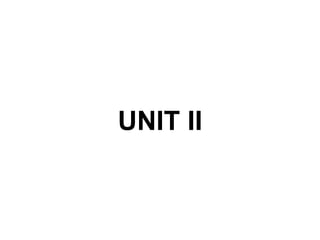
UNIT II.ppt
- 1. UNIT II
- 2. Aggregates used for concrete making • Concrete The Extensively used material after water because of the following reasons • Versatile • Pliable when mixed • Strong & Durable • Does not Rust or Rot • Does Not Need a Coating • Resists Fire • Almost Suitable for any Environmental Exposure Conditions
- 3. Concrete is a Rocklike Material • Ingredients • – Portland Cement • – Coarse Aggregate • – Fine Aggregate • – Water • Admixtures (optional)
- 5. Why use aggregate • Reduce the cost of the concrete 1/4 - 1/8 of the cement price • Reduce thermal cracking • – 100 kg of OPC produces about 12oC temperature rise • Reduces shrinkage • – 10% reduction in aggregate volume can double shrinkage • High aggregate : cement ratio (A/C) desirable • A/C mainly influenced by cement content • Imparts unit weight to concrete
- 6. Aggregate Classification • Aggregates are classified as below: • Based on • size:- F.A & C.A. • Specific Gravity:- Light Weight, Normal Weight and Heavy Weight • Aggregates. • Availability:- Natural Gravel and Crushed Aggregates. • Shape:- Round, Cubical, Angular, Elongated and Flaky Aggregates. • Texture:- Smooth, Granular, Crystalline, honeycombed and Porous.
- 7. Aggregate Classification • There are two types of Aggregates used in concrete making based on their size: Coarse Aggregates. Fine Aggregates. • Fine Aggregate • Sand and/or crushed stone. • < 4.75 mm. • F.A. content usually 35% to 45% by mass or volume of total aggregate.
- 8. Aggregate Classification • Coarse Aggregate • Gravel and crushed stone. • 4.75 mm. • typically between 9.5 and 37.5 mm.
- 9. Rock and Mineral Constituents in Aggregates 1.Minerals • Silica • Silicates • Carbonate • Calcite, DolomiteSulfate • Sulfate • Gypsum, Anhydrite • Iron sulfide • Pyrite, Marcasite • Iron oxide • Magnetite, Hematite
- 10. Rock and Mineral Constituents in Aggregates 2.Igneous rocks • Granite • Syenite • Diorite • Gabbro • Peridotite • Pegmatite • Volcanic glass • Felsite
- 11. Rock and Mineral Constituents in Aggregates • Sedimentary rocks • Conglomerate • Sandstone • Claystone, siltstone, argillite, and shale • Carbonates • Chert
- 12. Rock and Mineral Constituents in Aggregates • Metamorphic rocks • Marble • Metaquartzite • Slate • Phyllite • Schist
- 13. Normal-Weight Aggregate • Most common aggregates • Sand • Gravel • Crushed stone • Produce normal-weight concrete 2200 to 2400 kg/m3
- 14. Lightweight Aggregate Expanded • Shale • Clay • Slate • Slag Produce structural lightweight concrete 1350 to 1850 kg/m3 • Pumice • Scoria • Perlite • Vermiculite • Diatomite
- 15. Heavyweight Aggregate • Barite • Limonite • Magnetite • Ilmenite • Hematite • Iron • Steel punchings or shot • Produce high-density concrete up to 6400 kg/m3
- 16. Aggregate Characteristics • Grading of Aggregates • Grading is the particle-size distribution of an aggregate as determined by a sieve analysisusing wire mesh sieves with square openings. • As per IS:2386(Part-1) • Fine aggregate6 standard sieves with openings from 150 μm to 4.75 mm. • Coarse aggregate5 sieves with openings from 4.75mm to 80 mm.
- 17. Aggregate Characteristics • Good Gradation • Concrete with good gradation will have fewer voids to be filled with cement paste ( economical mix) • Concrete with good gradation will have fewer voids for water to permeate ( durability) • Particle size distribution affects: • Workability • Mix proportioning • Freeze-thaw resistance ( durability)
- 18. Aggregate Characteristics • Fineness Modulus (FM) • The results of aggregate sieve analysis is expressed by a number called Fineness Modulus. Obtained by adding the sum of the cumulative percentages by mass of a sample aggregate retained on each of a specified series of sieves and dividing the sum by 100. • The specified sieves are: 150 μm (No. 100), 300 μm (No. 50), 600 μm (No. 30), 1.18 mm (No. 16), 2.36 mm (No. 8), 4.75 mm (No. 4), 9.5 mm ,
- 19. Aggregate Characteristics • Moisture In Aggregates • Aggregates have two types of moisture: • 1. Absorbed moisture – retained in pores • 2. Surface moisture – water attached to surface • Aggregates have four moisture states: • Oven dry: all moisture removed • Air dry: internal pores partially full & surface dry
- 20. Aggregate Characteristics • Saturated-surface dry: pores full & surface moisture removed • Wet: pores full and surface film
- 21. Aggregate Characteristics • texture of aggregates Ideal aggregates: • spherical or cubical • round shape, fine porous surface reduced particle interaction (friction) results in good workability and good surface area for bonding • natural sands are good examples of this
- 22. Aggregate Characteristics Non Ideal aggregates: • angular • elongated • flaky or rough • high particle interaction • requires more cement paste to achieve workability • results in increased cost
- 23. Segregation • Segregation is defined as the separation of the constituents of a homogeneous mixture of concrete. • It is caused by the differences in sizes and weights of the constituent particles. • The second form of segregation occurs in very wet mixes in which the cement – water paste separates from the mix • In dry mixes, heavier particles move away and occupy the edges of the flow table
- 24. Bleeding • Bleeding is also known as ‘water gain’. • It is the accumulation of water at the surface, which accompanies the sedimentation of freshly mixed concrete. • This happens due to the inability of the solid constituents of the mix to hold all the mixing water and they settle downwards due to gravity and the water moves upwards.